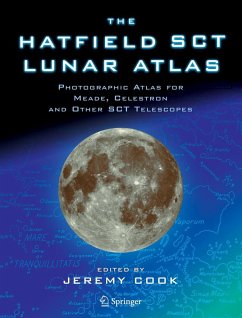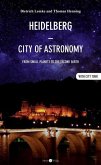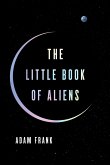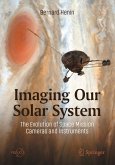SCT and Maksutov telescopes - which of course includes the best-selling models from Meade, Celestron, and other important manufacturers - reverse the visual image left for right, giving a "mirror image". This makes it extremely difficult to identify lunar features at the eyepiece of one of these instruments using conventional atlases, which show the Moon "upside-down" with south at the top.
This new SCT version of Hatfield's famous lunar atlas solves the problem. Photographs and key maps in the Hatfield SCT Lunar Atlas are exactly as the Moon appears through the eyepiece of an SCT or Maksutov telescope. Smaller IAU-standard reference photographs are included on each page, to make it simple to compare the mirrored SCT photographs and maps with those that appear in other atlases.
This edition uses the superb original photographs taken by Commander Henry Hatfield using his purpose-built 12-inch reflector. The key maps, on which lunar features can be readily identified, retain the style and clarity that made the original justly famous.
This new SCT version of Hatfield's famous lunar atlas solves the problem. Photographs and key maps in the Hatfield SCT Lunar Atlas are exactly as the Moon appears through the eyepiece of an SCT or Maksutov telescope. Smaller IAU-standard reference photographs are included on each page, to make it simple to compare the mirrored SCT photographs and maps with those that appear in other atlases.
This edition uses the superb original photographs taken by Commander Henry Hatfield using his purpose-built 12-inch reflector. The key maps, on which lunar features can be readily identified, retain the style and clarity that made the original justly famous.
From the reviews:
"This book was the last and posthumous work of the noted British amateur astronomer ... . the observer can study the moon with the eyepiece in one hand and the lunar atlas in the other, matching the part of the moon observed with the photographs and maps in the other. It is an effective, fast way of learning the Moon. ... an amateur's introduction to the magic of lunar observing, this is perfect and experienced observers will enjoy the photographs and maps just as much." (Brian Harvey, Astronomy and Space, August, 2006)
"The Hatfield SCT Lunar Atlas was developed specifically to help amateur observers locate the objects they observe ... . The atlas is divided into 16 sections, each of which contains a map and photographic plates showing the Moon at different 'ages' and lighting conditions. There is also an index of named formations, complete with map references and latitude/longitude figures. ... This is a relatively simple book ... will be of great interest to any serious telescopic observers of the Moon." (International Space Review, 2006)
"In the late 1990s Henry gave his permission for the British Astronomical Association to republish the atlas ... . The result was a modern and very readable lunar atlas that, just like the original, showed the Moon exactly as it would appear through a beginner's telescope, at each lunar phase. The strength of the atlas has always been that it shows the Moon clearly ... . The Hatfield SCT Lunar Atlas is as valuable to beginners as it has ever been." (Martin Mobberley, Astronomy Now, 2006)
"This book takes a classic work and brings it up to date for the modern observer. ... For those just starting out, this atlas can be picked up, opened and used to find the crater that is being seen through the telescope. More experienced observers can also use it to identify those small features. Those who have ... to make the investment in an instrument may wish to study thesurface enabling a faster identification of topographical features." (AlanWells, Journal of the British Astronomical Association, Vol. 116 (1), 2006)
"This book was the last and posthumous work of the noted British amateur astronomer ... . the observer can study the moon with the eyepiece in one hand and the lunar atlas in the other, matching the part of the moon observed with the photographs and maps in the other. It is an effective, fast way of learning the Moon. ... an amateur's introduction to the magic of lunar observing, this is perfect and experienced observers will enjoy the photographs and maps just as much." (Brian Harvey, Astronomy and Space, August, 2006)
"The Hatfield SCT Lunar Atlas was developed specifically to help amateur observers locate the objects they observe ... . The atlas is divided into 16 sections, each of which contains a map and photographic plates showing the Moon at different 'ages' and lighting conditions. There is also an index of named formations, complete with map references and latitude/longitude figures. ... This is a relatively simple book ... will be of great interest to any serious telescopic observers of the Moon." (International Space Review, 2006)
"In the late 1990s Henry gave his permission for the British Astronomical Association to republish the atlas ... . The result was a modern and very readable lunar atlas that, just like the original, showed the Moon exactly as it would appear through a beginner's telescope, at each lunar phase. The strength of the atlas has always been that it shows the Moon clearly ... . The Hatfield SCT Lunar Atlas is as valuable to beginners as it has ever been." (Martin Mobberley, Astronomy Now, 2006)
"This book takes a classic work and brings it up to date for the modern observer. ... For those just starting out, this atlas can be picked up, opened and used to find the crater that is being seen through the telescope. More experienced observers can also use it to identify those small features. Those who have ... to make the investment in an instrument may wish to study thesurface enabling a faster identification of topographical features." (AlanWells, Journal of the British Astronomical Association, Vol. 116 (1), 2006)








